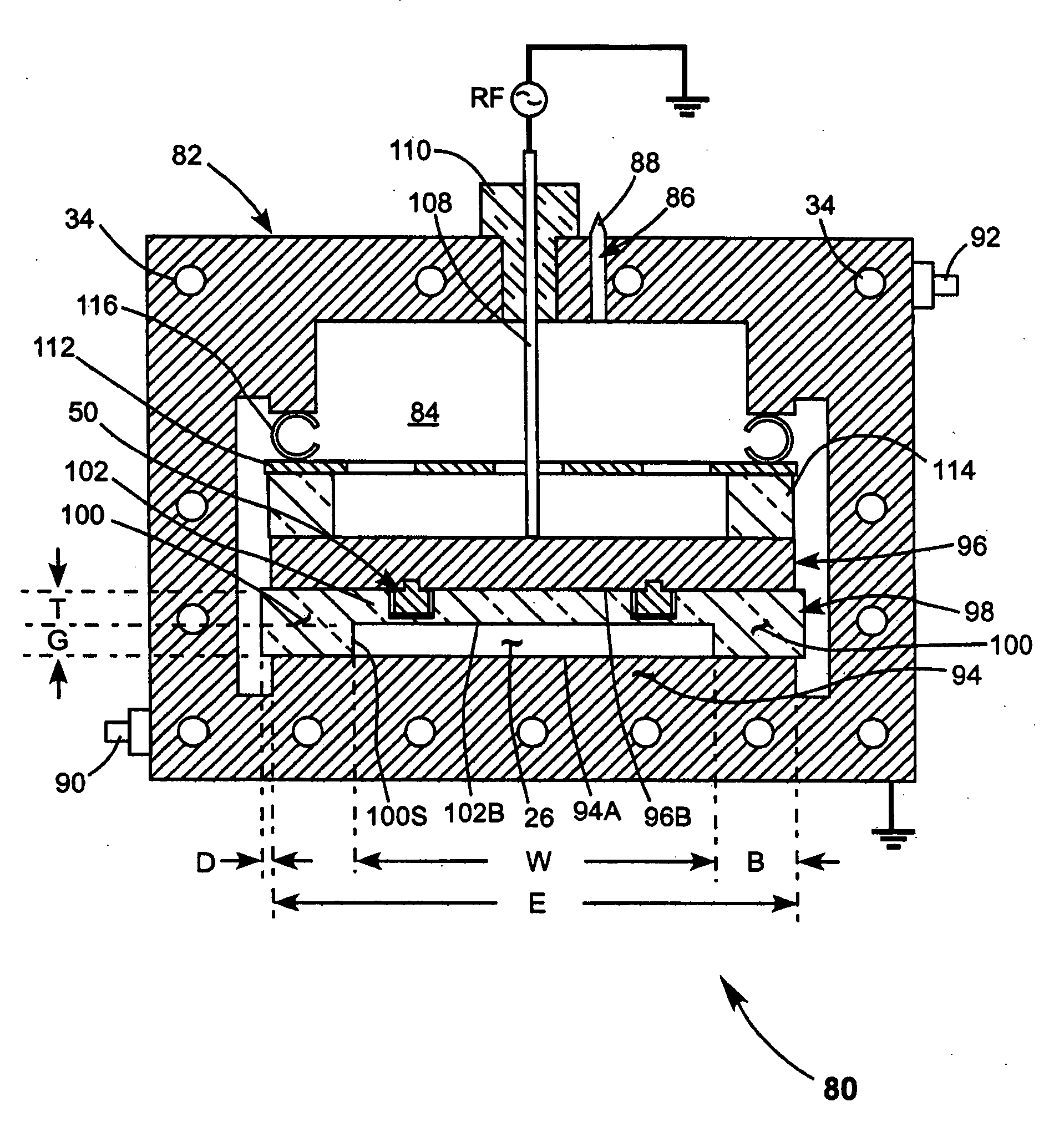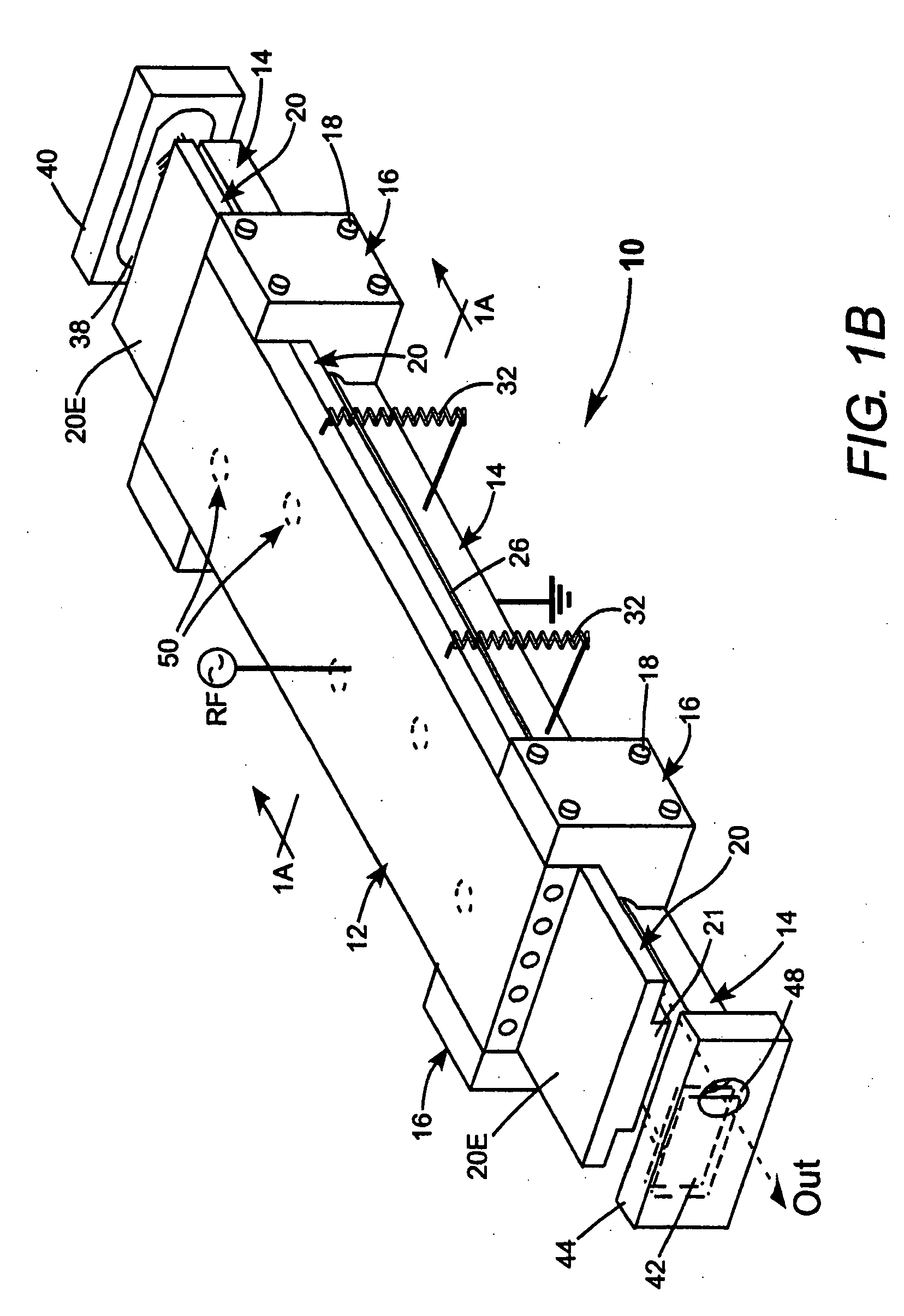Dielectric coupled CO2 slab laser
a co2 and laser technology, applied in the direction of laser details, gas laser construction details, active medium materials, etc., can solve the problems of rf discharge collapse, affecting the mode quality and efficiency of laser, and further arc collaps
- Summary
- Abstract
- Description
- Claims
- Application Information
AI Technical Summary
Benefits of technology
Problems solved by technology
Method used
Image
Examples
embodiment 80
[0039]FIG. 4 is a cross-section view schematically illustrating an embodiment 80 of a slab CO2 laser in accordance with the present invention integrated into a metal enclosure 82. FIG. 5 is three-dimensional view schematically illustrating laser 80 with enclosure 82 partially cut away. Enclosure 82 is preferably formed from extruded aluminum components and is electrically connected to ground potential. Interior 84 of enclosure 82 is filled with a lasing gas via a port 86, the tip 88 of which can be sealed off, to seal enclosure 82 once lasing-gas filling is complete. Cooling channels 34 are provided in the base, sidewalls, and top of enclosure 82. Cooling fluid is directed into the channels via an inlet port 90 and exits the channels via an outlet port 92.
[0040] A raised base-portion 94 of enclosure 82 forms a ground electrode for slab laser 80. Electrode 94 has a width E. A separate top or “hot” electrode 96 is spaced apart from ground electrode 94 by a ceramic slab 98 having raise...
embodiment 130
[0047]FIG. 8 schematically illustrates an embodiment 130 of a slab CO2 laser in accordance with the present invention. Laser 130 is similar to laser 90 of FIG. 7 with an exception that in addition to a ceramic slab 120 in contact with electrode 94, there is a similar ceramic slab 121 in contact with hot electrode 96. In laser 90, discharge gap 26 is formed between lower surface 121B of ceramic slab 121 and upper surface 120A of ceramic slab 120.
[0048] One disadvantage of including two dielectric slabs and forming the discharge gap between those slabs is that laser output will not be plane polarized as would be the case in embodiments of the inventive laser wherein the discharge gap is formed between a dielectric slab and a metal electrode. If a polarized output is required a separate polarizer (not shown in FIG. 8) should be included in resonator 36.
embodiment 140
[0049] Another further embodiment 140 of a slab laser in accordance with the present invention is schematically illustrated in FIG. 9. Laser 140 is similar to laser 60 of FIG. 2 with an exception that ceramic slab 21 of laser 60 is replaced with a slab 142 that is held in contact with hot electrode 12. Slab 142 is wider than electrode 12, such that an edge portion 142E of the slab extends laterally beyond the electrode for reasons discussed above. Detail of the holding arrangement is depicted in FIG. 9A. Here a bolt 144, having a head 146 and a post 148, has head 146 thereof bonded via a solder bond 152 to metal pad 150 that is deposited on slab 142. A plurality of such bonded bolts, here four, are disposed along the length of slab 142. The bolts extend through holes (not shown) in electrode 12. Nuts 154 and spring washers 156 are attached to the posts to hold the ceramic slab in contact with the electrode (see FIG. 9). The spring washers accommodate relative difference in expansion...
PUM
 Login to View More
Login to View More Abstract
Description
Claims
Application Information
 Login to View More
Login to View More - R&D
- Intellectual Property
- Life Sciences
- Materials
- Tech Scout
- Unparalleled Data Quality
- Higher Quality Content
- 60% Fewer Hallucinations
Browse by: Latest US Patents, China's latest patents, Technical Efficacy Thesaurus, Application Domain, Technology Topic, Popular Technical Reports.
© 2025 PatSnap. All rights reserved.Legal|Privacy policy|Modern Slavery Act Transparency Statement|Sitemap|About US| Contact US: help@patsnap.com



